The Ultimate Guide to Ultralight Tents
Posted by Andy Neil on Feb 17, 2025
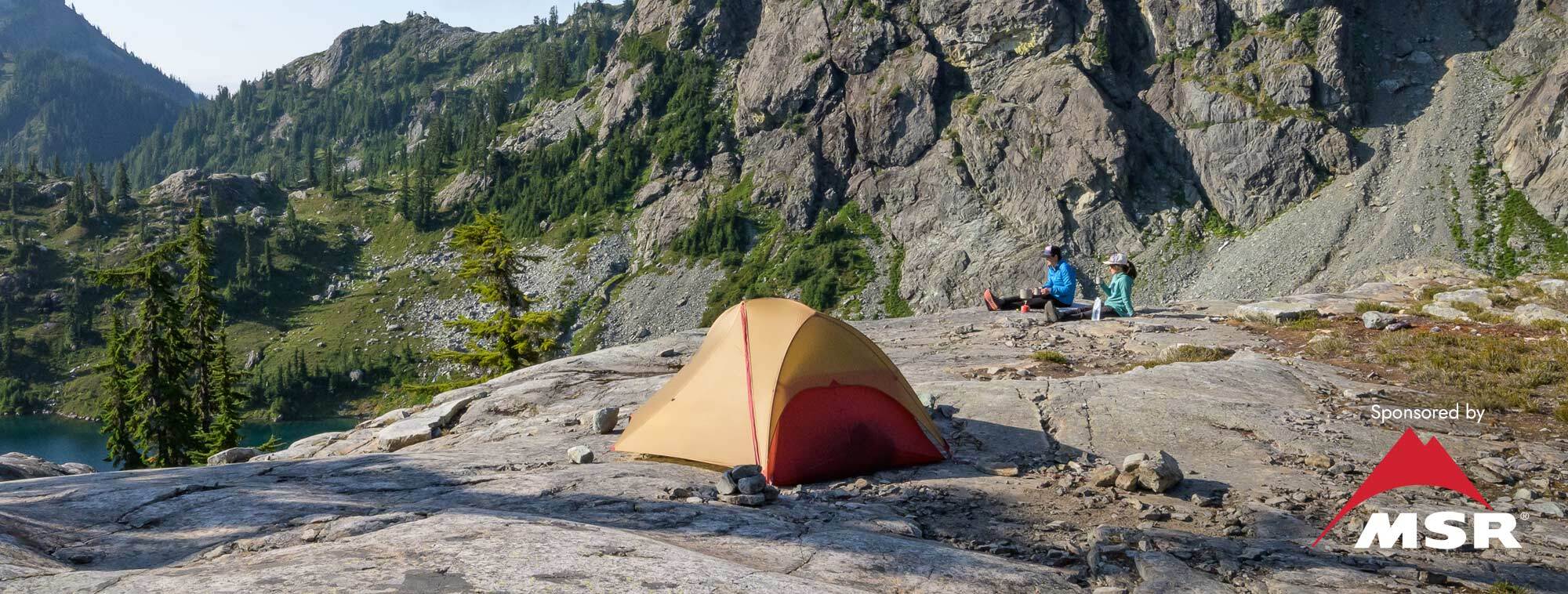
Choosing a lightweight tent can be difficult given the wide range available; we have a wide variety of tents, and we want to ensure you get the right tent for whatever adventures you have. So here are some of the things to consider when you are in the market for a new tent.
Here at Ultralight outdoor gear, we weigh every tent ourselves; the manufacturer’s weight can sometimes be inaccurate, so we find it best to unpack each new tent and put it on our scales so that you are better informed. The weights we quote do not include the tent bags or the tent pegs the tent comes with, as many of our customers will have their own lightweight pegs; we also find tent bags can sometimes be unnecessary, so we, like many of you, consider every gram we can.
3 Season vs 4 Season Tents
Giving a tent a “seasonal” rating can be a tad confusing; four-season tents are made from heavier fabrics, with a higher waterproof rating, and are designed to stand up to more extreme weather, including heavy snow; the rain-fly will extend right to the floor, to prevent wind, rain and snow from entering the tent. The inner tent will be made from fabric instead of mesh to retain heat better.
Three-season tents, however, are much lighter; the rain cover and vestibule will sit off the ground to provide as much ventilation as possible, which helps prevent condensation. They are designed to have increased ventilation.
Here in the UK, 4 season tents are used by wild campers who love sleeping in the high places, where you are more exposed to changeable weather.
As Four Season tents are generally heavier than their 3 season counterparts, if you don't need 4 season performance, then you are carrying significantly more weight for no reason. In warmer climates, your tent will be uncomfortably hot. Our view is to get the tent most suited to the type of backpacking you do.
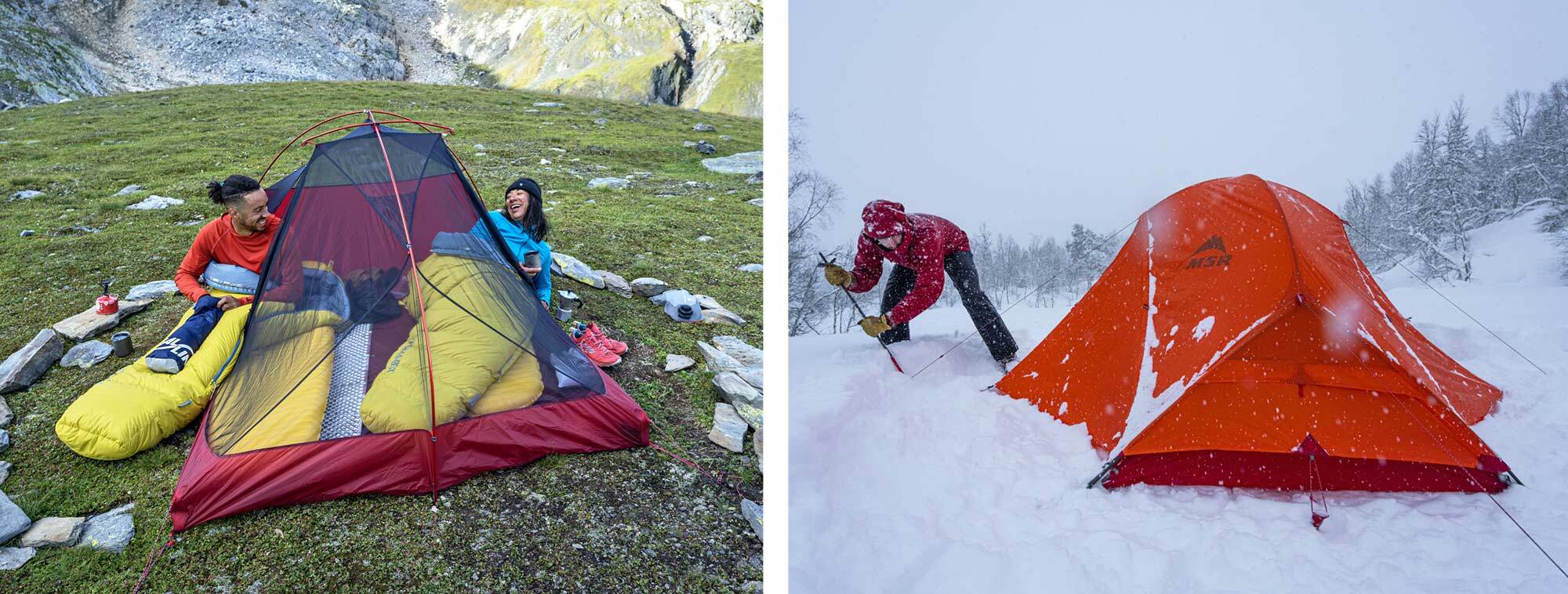
One Person, Two Person, 3 Person, more?
Ultralight tents come in all shapes and sizes, the lightest may feel cramped, especially if you are a big person, and it may be worth considering a slightly heavier model with more space. For long treks, some people will take a tent the next size up, so a solo trekker might take a two-person tent, especially if they are embarking on a long trek, or a couple might take a three-person tent just to get the extra space.
One Person Tents
One-person tents are the lightest and most low-profile on offer, brilliant for fast-paced, long-distance treks, overnight trail runs, and those trying to shed every gram they can. Some, one step up from a bivvy bag, are simple to erect and take up little floor space so that you can pitch just about anywhere. Simple shelters to bed down for the night in; however, they can be cramped and have very little headroom, not somewhere you want to spend much time.
More “traditional” one-person tents, offer a more liveable space and are more comfortable to be confined if bad weather has forced you to make camp early. They provide more room for gear, to sit up and cook or change clothes. It will have more features like pockets to store items you want close at hand.
Two Person Tents
The jump from one man to two can add a little weight, but it vastly increases the room inside the tent to accommodate you and a tent partner. When looking at two-person tents, my primary consideration would be how many doors it has. If you are sharing a tent with a partner, you don’t want to have to be clambering over each other in the middle of the night if one of you needs to get out of the tent. Tents that have one front door, which can easily be accessible by both parties. However, most tents will have two doors, one on either side of the tent, so both parties have their own entrance and vestibule. Tents that only have a single door tend to be tunnel designs where you sleep with your head at the door, which is not as convenient as having your own doorway, but tunnel designs tend to have better headroom and internal volume, which may be a worthwhile trade-off.
All two-person tents will be large enough for two pads to bed down next to each other, but most two-person tents are used solo. For one-night trips or short excursions, two people can comfortably co-habit in a two-person tent, but for longer trips or even for one night away, many people prefer the space of a two-person tent just for themselves. There is plenty of room to keep gear inside the tent, a luxury many one-person tents don’t offer. Two-person tents allow you to sprawl out, so if you are in the tent for long periods due to bad weather or are on a long-distance trek, you have a much nicer place to hang out.
3+ Person Tents
Three-person tents offer a lot more room and make for a spacious tent for two if you are prepared to carry a little extra weight for a lot more comfort. Three-person tents are perfect for families, those with dogs or those who wish to take more gear with them. They can be used as a “base camp”, a base to set up and explore an area and tick off some fells.
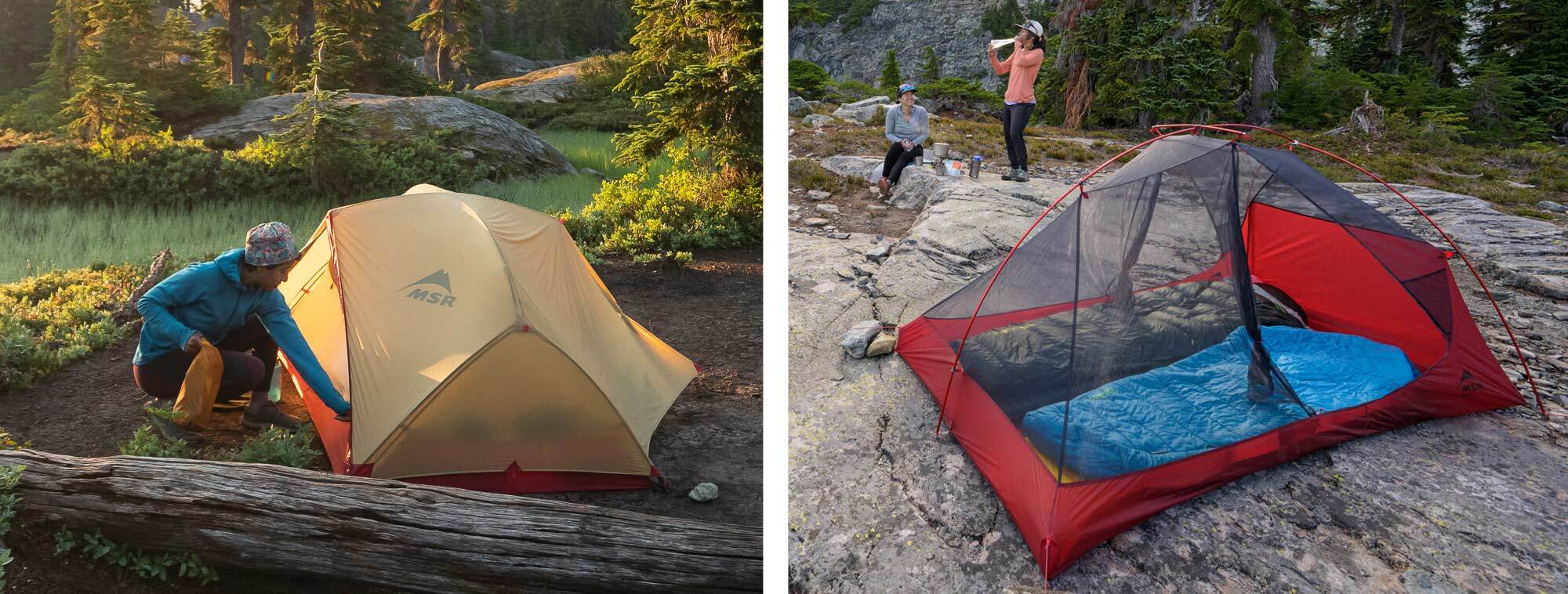
Tent Structure
Geodesic
Geodesic or “dome” tents are simple to pitch and stand up well to bad weather; flexible tent poles crisscross over one another to provide the structure and support for the tent. This design is the most stable in harsh weather conditions though they are usually on the heavy end of the scale. These make the best 4-season tents are usually “free-standing” and are recommended for those who love to summit camp.
Wishbone Tents
Wishbone tents are relatively new to the market but are some of the lightest tents on offer. Similar to a geodesic tent, they use a flexible pole to support the tent. However, the poles do not cross over each other; all the poles are connected and easily fit together. Wishbone tents will either have a Y-shaped pole structure or an X-shaped pole structure. Y-shaped pole structures can be fastened into the internal tent seems, which adds more stability; they can still suffer in side winds, as they only have 3 points of contact with the tent floor; we find that stability and volume can be added to the tent with the use of Grip Clips which provide additional guylines point and a more secure pitch.
X-shaped pole structures, as they have 4 points of contact with the tent floor, are more stable in strong winds and bad weather but tend to weigh more. Both X- and Y- Shaped Wishbone tents tend to have a volumising pole, which rotate and dramatically increase the tent’s liveable space as well as distributing the flysheets tension evenly, resulting in a tauter pitch.
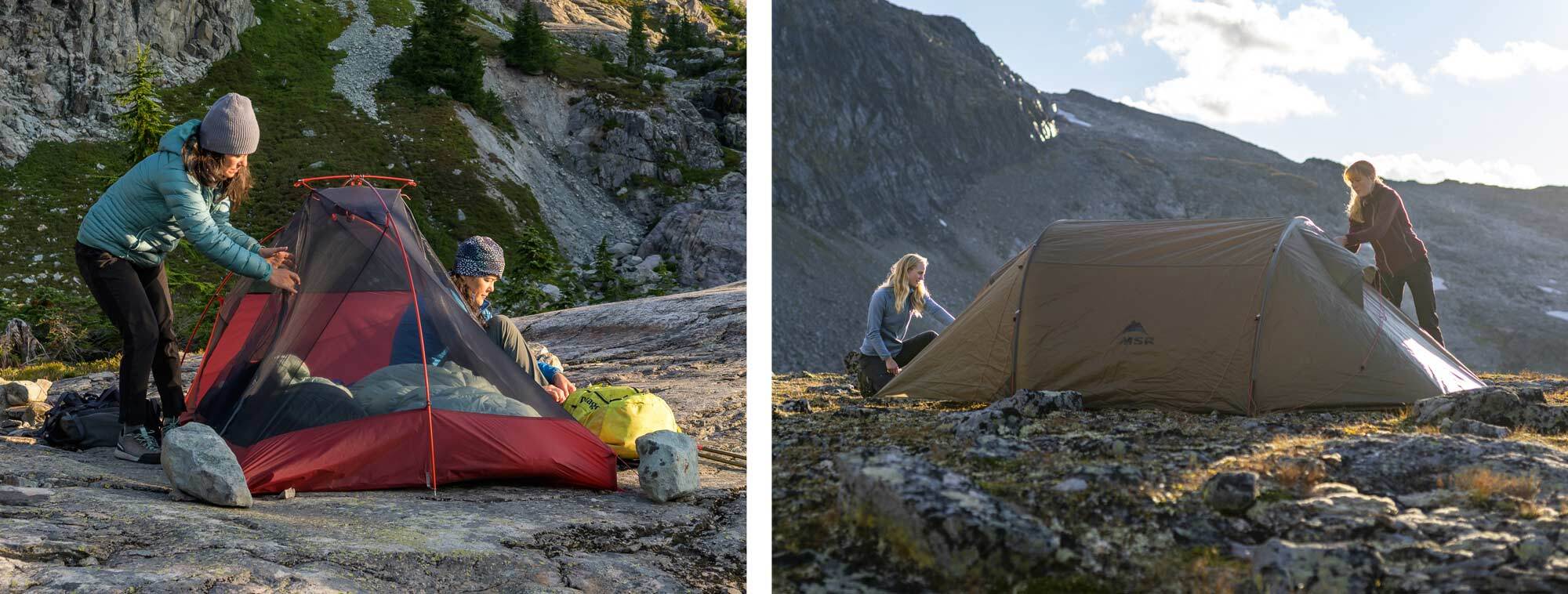
Tunnel Tents
Dome tents don’t always offer the most significant amount of liveable space; for those who like a bit more room when we camp (a place for your bike, an area for your dog, or a dedicated place to cook), tunnel tents are a fantastic choice. Tunnel tents use flexible poles bent into semi-circles at either end, sometimes in the middle, to support the tent; this makes them incredibly easy to pitch; though they are not as stable as dome tents. They are fantastic if you go from camp site to campsite, but not for sleeping in exposed spots in lousy weather. Some tunnel tents, such as the Terra Nova Laser Compact, only use one pole across the middle of the tent; these tend to be small one or two-person, low-profile tents that handle bad weather well.
Trekking Pole Tents
The obvious advantage of a trekking pole tent is that it eliminates the need to bring tent poles; instead, hiking poles are used to support the tent. Of course, this saves on weight but also makes the tent incredibly malleable, so it can easily be accommodated in your rucksack. Not carrying long rigid tent poles can also help to reduce pack size, which can go a long way when saving weight. They can provide much more headroom than a traditional one or two-person tent. Trekking pole tents tend to be single-skin tents, though 2-skinned trekking pole tents are available. Due to their high sides, they can struggle in strong winds. An excellent choice for long-distance walkers.
The Bivvy-Style Tent
Lightweight, low profile, and easy to pitch, the bivvy-style tent is the perfect one-person tent for those who just need somewhere to bed down for the night quickly; ultra-marathon runners, fast-pace hikers, and long-distance trail runners. Bivvy-style tents have an incredibly small footprint, which means they can be pitched just about anywhere, they are incredibly low profile, so they are not really affected by bad weather. However, they are ill-suited to anything other than sleeping in. Getting changed, reading a book, and cooking a dehydrated meal, are all a pain in such a confined space.
Bike Packing Tents
Bike-packing tents are designed to fit in small handlebar bags that can easily be strapped to a bike. They will have shorter pole section lengths than traditional tents to keep the pack size as small and as possible ; they will often have additional storage solutions for helmets and such.
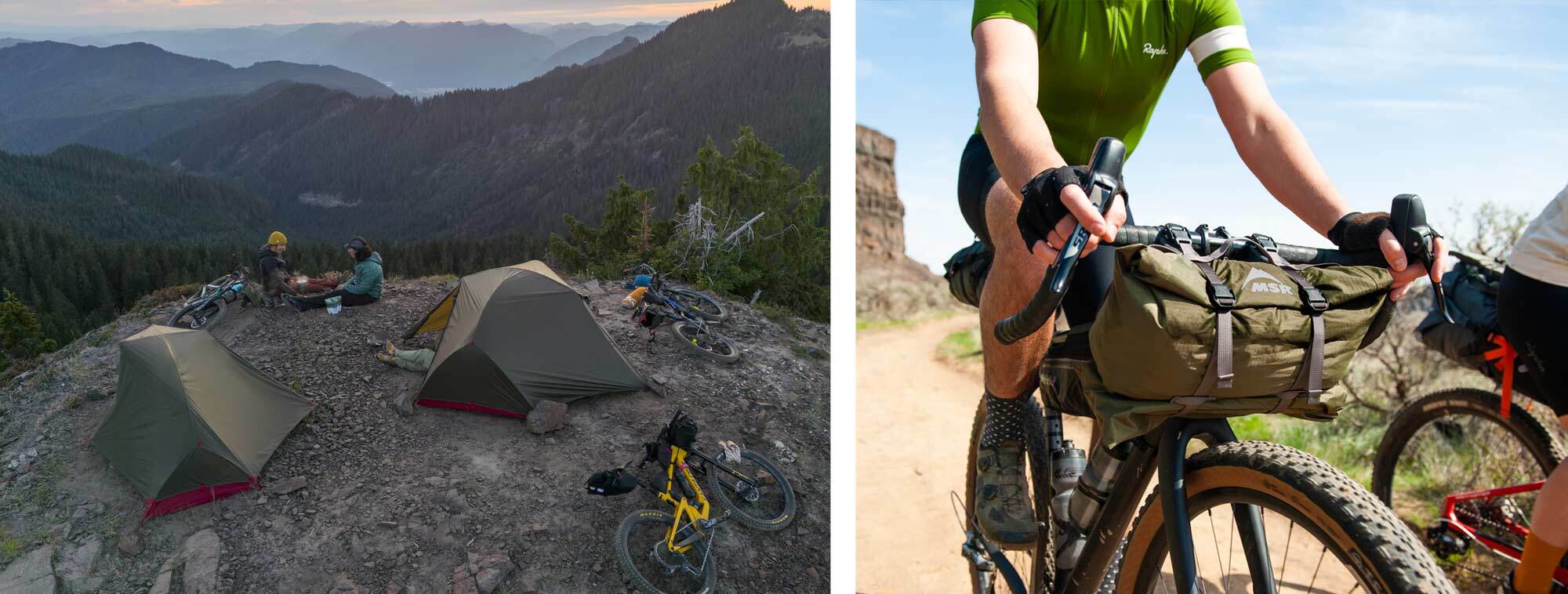
Other considerations
Free-Standing vs Pitched
A free-standing tent is a tent that will stand by itself without any additional pegs - though you usually need to peg it out to make it taught and stop it from blowing away! You will always get a consistent pitch; the tent can even be picked up and moved to a more desirable spot if required. Perfect in rocky conditions when you cannot get tent pegs in the ground. Most wishbone tents are semi-freestanding and require the corners to be pegged out to get a taut pitch.
Pitched tents rely on tent pegs and guy lines for support; they can take practice to get the pitch just right.
Inner Pitch First vs Inner and Outer Together
Traditionally, most double-skinned tents require the inner tent to be pitched first, then the flysheet is attached and pegged out. In bad weather, this could mean the inside of your tent is open to the elements and could get the inner of the tent wet. This isn’t a massive concern for me, as the time between the inner going up and the fly going over the top is minimal. However, some disagree and want a tent that pitches inner and outer at the same time. The tents that pitch inner and outer first tend to be four seasons and, therefore, generally heavier.
Single-Skin vs Two-Skin tents
Single-skin tents are a fantastic way to shave weight, though they come with a caveat: condensation, which undoubtedly will be an issue at some point. Condensation is not necessarily a problem; mopping pooled water with a cloth is a simple and easy fix, but some do not wish to deal with this, especially in the morning. With two skin tents, water vapour from your breath passes through the inner tent and the condensation forms inside the flysheet.
Gear Storage
Most tents provide at least one pocket to store items you need close at hand, such as medication or glasses. However, some manufacturers, have turned gear storage into an art form and excel at creating pockets in nooks and crannies to keep your gear organised and close at hand.
 |
||
 |
||
| Andy Neil |
||
|
Andy has been a keen long-distance hiker and wild camping enthusiast since he completed the Cleveland Way in 2015. Since then, he has walked thousands of trail miles all over the UK and is an active member of the Wild Camping UK community, being an admin of the largest wild camping community on Facebook. He strongly advocates for responsible wild camping and believes it is important to leave no trace when camping in the wilderness. He joined the UOG team in 2021 and works as a website developer and content creator. |
||
